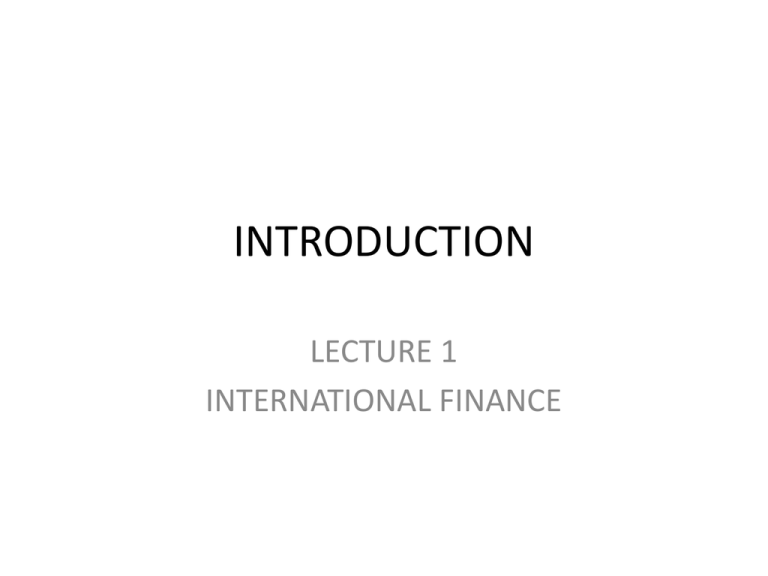risk - Department of Development Studies
advertisement

INTRODUCTION LECTURE 1 INTERNATIONAL FINANCE Outline of presentation • • • • • • • Learning objectives Introduction to international finance Risk and returns Country-risk Financial Process Concluding remarks Review questions UNIT 1: KEY CONCEPTS IN FINANCE INTRODUCTION What is finance? • Allocation of scarce resources over time. • Differences between financial and other resource allocation decisions: – Spread out over time – Often not known with certainty in advance by either decision makers or anybody else. • The financial system is used by economic agents in the exchange of assets and risks. • Financial system is given as a set of markets and institutions that facilitate transactions involving the exchange of assets and risks. • Investment, a function of finance, has a direct effect on economic development. Sub-themes in finance • • • • • Personal finance Corporate finance Public finance International finance Development finance What is international finance? • It is concerned with the dynamics of: – exchange rates, – foreign investment, and how these affect international trade. • International finance also studies: – international projects, – capital flows, – trade deficits etc International finance • Covers several topical issues – – – – – What has/will happened to the rand, the dollar etc? Should China devalue the yuan? Should the UK give up its pound to join the euro? Should Greece default on its national debt? Should SA impose capital controls whenever the rand is too strong? – Should SADC share a single currency? – Should SACU continue to transfer resources to Swaziland and Lesotho? International finance • International finance is due to the effect of the influence of economic activity in other countries on local economies. – Countries trade with one another but different countries often have different currencies. – What determines the relative values of the various competing currencies. – Countries/cross-border firms borrow from each other. – International borrowing and lending economic opportunities are expanded and households’ welfare are improved. • Existence of banks makes bank runs possible similarly the international financial system makes international financial crisis possible. Regimes of international financial systems • • • • Bimetallism Gold standard WWI, Depression gold standard breaks down Bretton Woods – Breaksdown due to OPEC and Vietnam war – Can we blame globalistion? • Current non-system Current non-system • Some major currencies float, eg. Japan, US, UK • Some countries have eliminated their currencies to form currency unions, the euro. • Some countries peg to other major currencies: dollar, eg. China and many Asian countries. • Some countries ‘dirty float’ or manage exchange rates. • Currency boards and its variants. • Currency substitution, eg. Zimbabwe. Selected facts about the international financial system • In Sept 2011, international currency trade was 4 trillion US dollars/day. (Bloomberg). • Outstanding bonds world wide at the end of 2010 was 95 trillion dollars. • Size of world trade in 2010 was 15.2 trillion dollars. • US GDP 14.5 trillion; China 4.5trillion • Selected GDPs in Africa. – – – – South Africa, $363bn Nigeria, $193bn Angola, $84bn Botswana, $15bn Recent events • Euro crisis – – – – – Ireland Greece Portugal Spain Italy • Austerity measures across Europe, and stifling of growth etc. • Crisis unresolved – Fear of Greek default • Weakness of the rand Brief tour of recent SA data FDI (R million) South African cent per 1 unit of foreign currency Year Botswana Pula Japanese Yen Indian Rupee British Pound US Dollar 1990 139.9 1.8 14.8 461.4 258.8 1995 131.0 3.9 11.2 572.4 362.7 2000 136.0 6.4 15.4 1048.6 693.5 2005 125.3 5.8 14.2 1180.8 636.2 2007 114.6 6.0 17.1 1411.5 676.7 2008 120.4 8.1 18.9 1512.5 825.7 2009 117.7 9.0 17.4 1311.8 843.7 2010 107.8 8.3 16.0 1131.5 732.2 Source: SARB data files, 2012 Role of international finance in economic development • All competing growth theories are unanimous regarding the place of capital in determining economic growth. • Capital is finance by investments – Local and foreign. • Scarcity of capital locally creates necessitates sourcing of capital from overseas. • Hence the importance of international finance. Summary: Theory • Financial instruments, markets, and institutions arise to lessen the effects of information, enforcement, and transactions costs. • How well financial systems reduce information, enforcement, and transactions costs influences: • • • • savings rates, investment decisions, technological innovations, growth rates. • Changes in economic activity may impact financial systems with implications for economic growth. • The financial sector does play an important role in the development process. Summary: Evidence • Empirical literature on finance on growth. • Better functioning financial systems ease the external financing constraints that impede firm and industrial expansion. – This is one channel through which financial development matters for growth. • Countries with better functioning banks and markets grow faster, but the degree to which a country is bank-based or market-based does not matter much. Reference: Levine, Ross (1997), ‘‘Financial Development and Economic Growth: Views and Agenda,’’ Journal of Economic Literature, vol. 35, pp. 688-726 UNIT 1: OVERVIEW OF KEY CONCEPTS IN FINANCE UNCERTAINTY, RISK AND RETURNS Key concepts in finance • Key concepts – Risks – Returns • Financial Processes • The finance and monetary systems • Concluding Remarks Risk • Definition: – There are various attempts at defining risk in the literature [Holton, G.A. (2004), Defining risk, Financial Analysis Journal 60:6, 19-25] – Risk, according to Glyn Holton (2004) has two components: • Exposure • Uncertainty • Risk is defined here is as exposure to a proposition for which one is uncertain. Risk cont’d • Harry Markowitz’s seminal work that constitutes the basis of portfolio theory constitutes a body of models/theories that describes how investors can balance risk and returns. • Markowitz did not explicitly define risk in his work. • In Portfolio theory, risk is defined as the “variability of return on a given asset” Risk cont’d • Portfolio theory identifies two main kinds of risk: – Systematic/systemic risk – Unsystematic (idiosyncratic) risk • There are several forms of risk • Some of the risk forms may be related and hence difficult to isolate one from the other, but it’s not impossible to do so. Types of risk • • • • • • • • • Business risk Financial risk Purchasing power risk/inflation risk Interest rate risk Exchange rate risk Market risk Specific/idiosyncratic risk Project risk Country risk Business risk • Related to business operations and related decision-making processes. • Associated with the profit potential. • A firm may be successful (profitable) or fail (incur a loss). • Generally, business risk may arise from the uncertainty associated with business objectives: market size, revenues, profit etc Financial risk • Probability of loss emanating from the type of financing which could impair ability to provide adequate return. • The type of financial assets that constitute the capital structure of a business determines degree if financial risk. • In the event of failure, claimants to the firm’s assets are paid in the order of seniority. • Question: what happens to a heavily geared or leveraged firm’s profitability when interest rates suddenly escalates? Financial risk cont’d • • • • • • the receiver/liquidator certain preferred creditors (eg. Tax authorities) secured creditors (eg. trade creditors) holders of floating charges over assets unsecured creditors (eg.unsecured loans) holders of unsecured preference shares and loan stocks • ordinary share holders (equity) Inflation risk • The likelihood of inflation eroding the purchasing power of expected return or value of assets. • Issuance of inflation-linked bonds (ILB) are meant to provide inflation-adjusted/compensated returns to make bonds attractive. • South Africa: Inflation linked retail savings bonds; 3year GGILB, Ghana. Other countries that issues ILB include Brazil, Poland, Israel. • Interest rate risk • Risk to returns to capital due to variations in interest rates. • Interest rates surges immediately after purchasing bonds returns to the bond holder falls and the market value of the bond also falls. • Asset purchases with loans at variable interest rates transfer the burden of interest rate risk solely on the borrower Exchange rate/currency risk • Holding financial asset or liability other than one’s own currency exposes on to exchange rate risk. Exchange rate/currency risk cont’d • Exchange-rate risk may be the single biggest risk for holders of bonds that make interest and principal payments in a foreign currency. – A Namibian company A pays interest and principal on a R1,000mn bond with a 5% coupon in N$. If the exchange rate at the time of purchase is 1:1, then the 5% coupon payment is equal to N$50mn, and because of the exchange rate, it is equal to R50mn. If in a year’s time, the exchange rate is 1:085. The bond’s 5% coupon payment is still N$50mn, but its worth only R42.50mn. The South African investor has lost a portion of his return for reasons that has nothing to do with the Namibian issuer’s ability to pay. Market risk • Three different views of market risk can be identified: • Market theory perspective – Sensitivity of a security to changes in the broad market index (beta coefficient). • Development finance view – Marketability of a security, securities can’t be converted to cash easily e.g. Investing in securities on illiquid Exchanges. Project risk • Project risk ensues when a project is undertaken with long-term financing based on projected cash flow from the project. • If guarantees are provided by a Government, sovereign guarantee- then the lender deals with country risk instead of project risk. • Example: SA Gov’t loan guarantees for Eskom shifts project risk to country risk from the point of view of the lenders Idiosyncratic/specific risk • Specific risk associated with the changes in a company’s share price due to firm specific factors. • It may be due: – Raw material price changes – Industrial action – Take-over bid (Massmart and Walmat deal) – Technology discovery of consequence to the firm Country risk • This is the risk of default or rescheduling of national debt. • Independent institutions have developed models for measuring country risk. • Assessment is based on a large number of factors. • The rating of a country may affect the financial institutions in the country. • Poor ratings results in high cost of capital. • High cost of capital have negative effect on economic growth. – Eg. Greece’s 10yr bond yield is 28 percent with a credit rating of junk status. – Germany with investment grade rating of AAA borrows at less than 2 percent. UNIT 1: KEY CONCEPTS IN FINANCE NOMINAL AND REAL RETURNS RETURNS • Returns are compensations for deferred consumption. • Desire to protect the value of financial assets. • Payment for accepting the risk of postponing consumption. • The trade-off between risk and returns underpins capital market theory. KEY CONCEPTS IN INTERNATIONAL FINANCE COUNTRY RISK Quantitative method • • • • • Econometric approach and modelization Analytical approach: crisis typology (Indosuez) Principal Component Analysis Logit Analysis Non-linear conditional analysis (threshold levels & breaking points: TAC) Quantitative method • Approach: – Transforming a number of observations (Delphi method, surveys) or quantitative indicators into one number. • The various indicators may be weighted in terms of their impact on creditworthiness and risk. • End-product: – one single grade to assess past and current country risk situation with possible cross-country comparisons across time. Assessment of country risk • Qualitative – a qualitative assessment of the financial, macroeconomic, legal, regulatory and political situation in a given country. – Some of the rating agencies that use the qualitative approach include Euromoney and Beri SA. – Example: Euromoney uses a 32-man panel of eminent economists in international financial institutions and another panel of political analysts to measure short-term risk of destabilization. – Outputs of the two panels are then weighted and used in coming up with the ratings. – Eg. Economic Intelligence Unit, Nord/Sud Export, e.t.c. Pros and cons of country risk analysis • Disadvantages/Cons – “reductionist” – Overly simplistic – risk of self-fulfilling prophecy – little predictive value – weighted average tends to bury salient trends – Gives “market consensus” often made of herd instinct • Advantages/Pros – Simple – Allows for crosscountry comparison. – Comparison over time. – Compresses a large number of variables into one single grade. Rating agencies • The agencies are expected to be independent third parties that are consulted in the course of a market transaction. • The goal is to deal with asymmetric information between both parties in the market using standardised assessement methods Weaknesses of the rating agencies • Power without accountability. • Conformity bias. • Penalisingof disobedient firms/countries that do not request a rating. • Pro-cyclical bias, hence following the majority opinion of market participants without early warning. • Downgrades amplify procyclicality. – E.g., cutting AIG’s debt rating in 2008, “sent investors rushing for the exit”. Response to short-comings of rating agencies. • Reliance on external rating has been reduced in some countries: – Japan (securities registration) – Argentina (for pension fund investments) Country risk analysis • The international capital market is a private initiative with no governmental influence, except legitimate regulatory initiatives. • The country risk outcome is usually reflected in the sovereign credit rating. • A favourable sovereign credit rating suggests that a country or private borrower from a given country can access capital at a relatively more favourable cost. There are many institutions that provide credit rating services. Credit Rating Agencies (CRA) • Credit Rating Agencies received heavy criticism for their role in the economic crisis that started in 2007 and continues currently. • America’s new Dodd-Frank Act now ensures a tighter supervision of CRAS in the US. • There currently over 76 rating agencies in the world. • Big three Credit Rating Agencies are: – – – – Standard and Poor’s (40% of market share) Fitch Ratings (40% of market share) Moody’s Investor Services (14 % of market share) Other +70 agencies (~ 6%) Selected ratings from S&P • Prime: AAA+, – Canada, Germany, UK • High grade: AA+, – US, France • Upper medium grade: A-, – Botswana • Lower medium grade: – Brazil, BBB; – SA, BBB+ • Non-investment grade speculative: – Angola,BB – – Indonesia, BB+, etc • Highly speculative: – Kenya, B+; Nigeria, B+ – Greece, CC Credit rating rankings for 2007 Concluding remarks • Country-risk analysis is a very demanding task. • Generally, no matter the rating agency or approach adopted in undertaking country risk assessment, qualitative or qualitative, a wide range of factors ought to be considered. • It is one thing to identify shortcomings of ratings, quite another to find alternative standards that are superior. UNIT 1: OVERVIEW OF KEY CONCEPTS IN FINANCE THE FINANCIAL PROCESS FINANCIAL PROCESSES • • • • • Mobilisation Intermediation Maturity transformation Risk transfer Financial deepening and financial repression (1) Mobilisation • Mobilisation is concerned with moving funds from savers to users of funds. • In developing countries savers have little inclination to place funds in financial assets even if they have access to them. • The thrust of the mobilisation effort is to encourage savers to invest in productive assets and not to invest in non-productive assets such as gold and cash. • In developing countries, informal financial institutions are also engaged in mobilisation of funds from savers. • Governments in most developing countries are directly involved in mobilisation through the sale of bonds. (2) Intermediation • The basic and most important • See to link savers and borrowers • Intermediaries provide indirect means of transferring funds from savers to borrowers – Transfer risk from lenders to intermediaries/borrowers – It provides focus in the form of institution/market attract potential borrowers – Opportunity for savers to deposit surplus funds and earn a return • Some savers will be unwilling to invest • Prospective savers may be unable to invest because they don’t have surplus funds. • The theory of intermediation is fundamental to financial repression. (3) Maturity transfer • Financial institutions also transfer short-term financial instruments into long-term financial instruments. • This important for long-term or project finance. • Two methods for maturity transfer – Taking short term deposits for long-term on lending • The law of large numbers enable financial institutions/banks to borrow “short” and lend “long”. • Large number of depositors reduces the risk of unexpected upsurge in withdrawals. – International banking lending (Eurocurrency market): funds are often deposited for 6months or less but monies are lent out for medium term duration i.e., 10yrs, 12yrs and sometimes 15yrs. • Buildings societies traditionally mobilize short-term funds and then lend them for long term, as mortgages may be payable in excess of 20years. (4) Risk transfer • In any investment, either in financial or physical assets risk is involved. • The division/apportionment of risk is important in mobilising and supply of fund for investment. • The simplest way of passing on the risk is for the party in a stronger position to refuse taking on the risk • Risk is transferred by: – Taking a security of one form or the other – By choice of financial instrument eg. DFI may take an equity stake or provide a loan. The more it puts in a loan the more risk it apportions to the other shareholders. 5. Financial deepening and financial repression • Financial deepening suggest an accumulation of financial assets at a faster rate the accumulation of non-financial wealth. • The thrust of the theory is that development of financial institutions and markets is a necessary condition for economic growth (Shaw 1973 and Mckinnon, 1973). • Developing countries suffer from financial repression which keeps finance “shallow” and thus restricting economic growth. • Financial repression is characterised by controls on interest rate either by government or oligopolistic institutions or markets; capital controls, over-valued exchange rates Financial deepening and financial repression cont’d • Poor development of the financial sector and or absence of institutions such as pension funds, capital and equity markets etc • Financial repression removes the incentives for private financial savings • Private individuals and institutions invest in non-financial assets: gold, land. • Theory is monetary based: money supply, its real value and real cost do matter in the process of economic growth. • The policy response leads to liberalisation of financial markets eg. Interest rates, removal of capital controls etc CONCLUSION Conclusion • Importance of finance in the development process.








